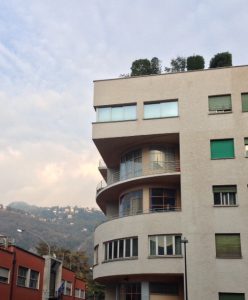
Giuseppe Terragni was one of the most important exponents of modern Italian architecture between the two world wars. Born in Meda in 1904 he studied at Milan Polytechnic University. His partnership with P. Lingeri and his participation in Gruppo Sette in 1926 were a key part of his training.
Gruppo Sette was a collective of professionals that sought to modernise architectural thought and the formal and functional research of Italian construction through the rationalist approach.
Terragni’s first construction, the “”Novocomum” apartment block, was one of the standard-bearing works of the modern movement in Italy, combining innovative materials (reinforced concrete) with clean volumes. But it was in the Casa del Fascio – 4 piazza del Popolo, Como – that a certain geometrical purism, reminiscent of Le Corbusier, was melded with the volume of the walls (covered with the marble) and the presence of large windows, to create an architecture destined to become a reference model for generations of architects. The materials (botticino, glass brick, glass and metal) are arranged in forms that create parallel and perpendicular lines, to harmonise the entire piece of architecture. Inside, Trani marble and Belgian black marble is also used, as well as painted plaster.
The building’s majestic qualities are suggested by the three steps that lead up to it from the road, and it dialogues with other entities in the vicinity: Brunate mountain, the Teatro Sociale, the Duomo. Entering through one of its 18 glass doors you come into a hall that leads to the building’s main rooms: the Director’s room, the offices and the galleries.
The hall is covered by glass brick curtains, between which there is a long sheet of glass that offers a glimpse of the hill above. Since 1957 it has been the headquarters of the provincial head of the Finance Police.
Terragni’s brief but decisive contribution to Italian rationalism and modern architecture in general can also be seen in his ability to oversee and embellish the solutions of other great European architects (Mies van der Rohe, Gropius, etc.) in a creative and original way. Examples include works and projects such as:
Casa Rustici (Milan, 1933-35)
Sant’Elia children’s nursery in Como (1934-37)
Villa Bianca in Seveso (1936-37)
Casa del Fascio in Lissone (1937-39)
projects for the town planning scheme of Como (1933-34)
It is also important to remember his very personal 20th century paintings (many of his drawings and paintings, mainly landscapes and portraits, form part of the G. Terragni Archive in Como)
